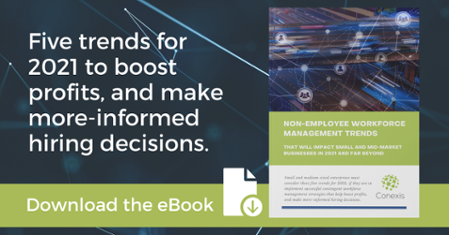If your business is based in the US, or has facilities located in the US, then it’s likely that you’ve come across the terms W2 employee and 1099 contractors during the hiring process.
1099s and W2s are simply the tax forms that employers use to report wages and taxes for different categories of workers. When hiring non-employee workers within your organization, it’s crucial that you understand the difference between these two workers.
Understanding the difference between W2 employees and 1099 contractors will ensure that your company doesn’t fall foul of workforce laws and regulations when engaging a non-employee workforce.
If you are unsure, Conexis VMS has created this blog to help you understand the difference between the two terms, with some information on how to determine which category a worker falls under.
What is a W2 Employee?
A W2 worker is an employee of the organization they work for. These employees can be full-time or part-time, and work according to the schedule and business policies of the company that employs them.
Since they are an employee of the organization, they are entitled to employee benefits such as vacation time, retirement plans, and sick leave. Employers are required to withhold Social Security and Medicare taxes for W2 employees, as well as file payroll taxes.
What is a 1099 Worker?
Unlike W2 employees, a 1099 worker is a self-employed worker or independent contractor. These types of workers are hired by companies to provide specific services for a specific project or designated period of time, as defined in a written contract.
Since 1099 workers are self-employed, they have the ability to define when, how and where they work from. They also can decide what tools and methods they use to complete that work, as long as they meet the deliverables of the business that’s hiring them.
Independent contractors are able to serve multiple clients at one time, and since they are self-employed they pay their own taxes and provide their own benefits. Employers must send a 1099-MISC tax form to these workers.
How to determine whether your workers are 1099 or W2 employees
Understanding the differences between these two categories of workers is a crucial component of ensuring your organization doesn’t misclassify an employee as an independent contractor.
Misclassifications can lead to W2 workers who are misclassified as independent contractors suing your business for the benefits they were denied (such as vacation pay, overtime, health insurance etc), as well as other costly fines and legal fees for your organization.
That’s why it’s important that your business classifies its workers correctly.
Here are a few questions that will help you get a clearer understanding of whether a worker falls under the W2 employee or 1099 contractor category.
Do you control how they do their job?
Independent contractors are self-employed, meaning they can work from where, when and how they want. Unlike a W2 worker who works for your organization, a 1099 independent contractor has far more freedom about how they deliver on the written contract. If you have control over how a worker works, it’s likely they fall under the employee category.
How do you pay the worker?
Unlike W2 employees who are paid a salary, independent contractors are usually paid by the job or for a specific period of time. Independent contractors certainly are not classified correctly if they are on your company’s payroll.
How long have you hired the worker for?
Independent contractors come and go from your organization depending on specific projects. After a project has been completed, they are able to work on different projects and with different organizations. If you are hiring an independent contractor long-term, it’s important to make sure that they aren’t accidentally falling into the employee category.
Most local jurisdictions have their own laws and regulations on how workers are categorized. To ensure you classify your workers correctly, most jurisdictions have online tests that will help your organization determine which category a worker belongs to.
Use a vendor management system (VMS) to ensure compliance
Managing a contingent workforce program can be incredibly complex, particularly when your company doesn’t have the tools in place to ensure it has complete control over its non-employee workers and the vendors associated with it.
Thankfully, the use of a vendor management system (VMS) makes this easy. A VMS acts as a centralized platform, giving you complete visibility into your non-employee workforce. Through proper documentation of your non-permanent workforce, your business will ensure it doesn’t misclassify independent contractors or temps.
Want to learn more about how a vendor management system can ensure your company correctly classifies its employees? Contact Conexis VMS today. We would love to answer any questions that you may have.




